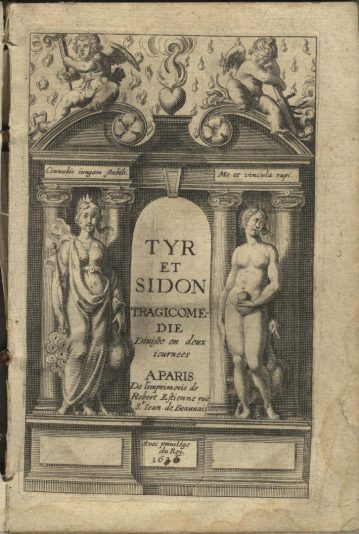Tyr et Sidon. Tragicomédie Divisée en Deux Journées ou les Funestes Amours de Belcar et Méliane.
Schelandre, (Jean de).
Synopsis
In defiance of all rules, the action of Tyr et Sidon proceeds alternately in Tyre where Belcar, prince of Sidon, is a prisoner, and in Sidon where Léonte, prince of Tyre, is a prisoner and pursues his gallant adventures. The play, which was divided into two days and ten acts, had a complicated plot and contained 5000 lines “[each day is divided in five acts in verse, with a preface by F. O. P., i.e. François Ogier Parisien]”. It required an immense stage on which the two towns were represented, with a field in between, where the contests took place.
Tyr et Sidon is noteworthy as an attempt to introduce the liberty of the Spanish and English drama into France, thus anticipating the romantic revolt of the 19th century. It is reprinted in the 8th volume of the Ancien Théâtre français. Schélandre was also the author of a Stuartide (1611), and of Les Sept Excellents Travaux de la pénitence de Saint Pierre (1636). Jean de Schélandre studied at the University of Paris. He then joined Turenne’s army in the Netherlands, where he gained rapid advancement. He was the author of a tragedy, Tyr et Sidon, ou les funestes amours de Belcar et Méliane, published in 1608 under the anagram- name Daniel d’Anchéres, and reprinted with numerous changes in 1628 under the author’s own name. It has been suggested that Schélandre was directly acquainted with Shakespearian drama, but of this there is no direct proof, although he appears to have spent some time in England and to have seen James I. He pursued his military career to the end of his life, dying at Saumazènes in 1635 from wounds received in the German campaign of Louis d’Epernon, Cardinal de la Valette.
Bibliographic references: Renouard Estienne p. 207; Soleinne, I, n.1030.






